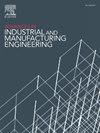Integrating 3D printing, simulations and surrogate modelling: A comprehensive study on additive manufacturing focusing on a metal twin-cantilever benchmark
IF 6
Q2 ENGINEERING, INDUSTRIAL
Advances in Industrial and Manufacturing Engineering
Pub Date : 2025-04-04
DOI:10.1016/j.aime.2025.100162
引用次数: 0
Abstract
Additive Manufacturing by powder bed fusion of metals using a laser beam (PBF-LB/M) is constantly growing as an advanced technology to produce metal components. It offers greater design freedom compared to conventional processes and allows the production of complex, lighter geometries with numerous applications in a variety of industries. However, the time and cost required to achieve production readiness present significant challenges to the widespread adoption of new parts development. Success in builds is not reliable until tested, with common issues including distortion, and warpage. The expensive costs of physical iteration to optimize parameters calls for digital simulation to mitigate build failures. This paper presents the successful development of a surrogate model for predicting distortion in a PBF-LB/M metal part. The methodology is grounded on a design of experiments, additive manufacturing tests, finite element modelling playing a critical role, alongside reduced order methods to achieve a surrogate model for improving the additive manufacturing process. The reduced order method for creating the surrogate model is based on tensor decomposition and designed for easy integration into a digital twin, while preserving the underlying physics by retaining the effects of input variables on the final output. The validity of the proposed approach is demonstrated through a benchmark example involving the manufacturing of a metal twin-cantilever part using different laser power, scan speed, and preheating conditions. The twin-cantilever surrogate model developed embeds physics-based simulations and facilitates efficient estimation of deflections. It offers accurate results useful during process setting calibration and improves understanding of how the process parameters affect the final built part.

集成3D打印,仿真和代理建模:以金属双悬臂基准为重点的增材制造综合研究
利用激光粉末床熔融金属的增材制造技术(PBF-LB/M)作为一种生产金属部件的先进技术正在不断发展。与传统工艺相比,它提供了更大的设计自由度,并允许生产复杂,更轻的几何形状,在各种行业中有许多应用。然而,实现生产准备所需的时间和成本对新零件开发的广泛采用提出了重大挑战。在测试之前,构建的成功是不可靠的,常见的问题包括扭曲和翘曲。优化参数的物理迭代的昂贵成本需要数字模拟来减轻构建失败。本文介绍了一个用于预测PBF-LB/M金属零件变形的代理模型的成功开发。该方法基于实验设计、增材制造测试、发挥关键作用的有限元建模,以及减少订单的方法,以实现替代模型,以改进增材制造过程。用于创建代理模型的降阶方法基于张量分解,旨在轻松集成到数字孪生中,同时通过保留输入变量对最终输出的影响来保留底层物理。通过不同激光功率、扫描速度和预热条件下的金属双悬臂零件的加工,验证了该方法的有效性。开发的双悬臂代理模型嵌入了基于物理的模拟,并促进了对挠度的有效估计。它提供了准确的结果,在过程设置校准有用,并提高了对工艺参数如何影响最终构建部分的理解。
本文章由计算机程序翻译,如有差异,请以英文原文为准。
求助全文
约1分钟内获得全文
求助全文
来源期刊

Advances in Industrial and Manufacturing Engineering
Engineering-Engineering (miscellaneous)
CiteScore
6.60
自引率
0.00%
发文量
31
审稿时长
18 days
 求助内容:
求助内容: 应助结果提醒方式:
应助结果提醒方式:


